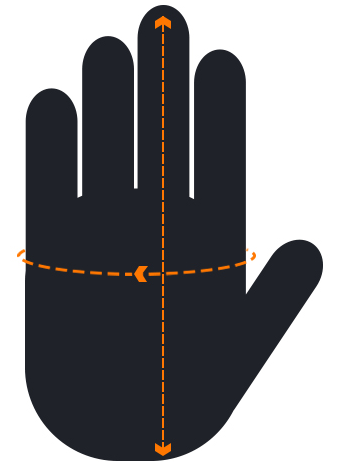Delta Plus VE801 Nitrex Chemical Safety Lab Gloves
Delta Plus VE801 Nitrex Chemical Safety Lab Gloves are resistant to n-Heptane, caustic soda (lye) and sulphuric acid and feature an extra long cuff that protects not only your hands, but your forearms too. Whether you deal with hazardous and harmful substances in a lab, on the farm or in a factory, proper hand and wrist protection is essential to keep you safe from the fallout caused by unexpected splashes and spillages.
What's Included?
- 1 x Pair of Safety Gloves
Sizing Information for Delta Plus VE801 Laboratory Gloves
To find your perfect size, simply measure the circumference of your palm (ignoring the thumb area) and the length of your hand as indicated in the image below. Once you have your measurements, please consult the sizing chart below to find the correct size for your hand.

| Glove Size | Hand Circumference (mm) | Hand Length (mm) |
| Size 7 | 178mm | 171mm |
| Size 8 | 203mm | 182mm |
| Size 9 | 229mm | 192mm |
| Size 10 | 254mm | 204mm |
If you're still struggling, click here to view our comprehensive safety glove sizing guide
How Do Nitrex Chemical Gloves Protect Your Hands?
Thanks to a durable and substance resistant nitrile coating, Delta Plus Nitrex Safety Gloves protect your hands against chemicals, abrasions, cuts and puncturing. They use an extended cuff to not only protect your hands, but guard the wrist and lower forearm against splashing and spillage.
Protection Standards and Ratings
Delta Plus VE801 Nitrex Chemical Safety Gloves meet the following specifications:
- EN 420:2003 + A1:2009
- EN 388:2003
- EN 374
EN 388
EN 388 is a European regulation governing the sale of gloves used for safety and protection. It determines the gloves' performance when used whilst working in and around mechanical machinery by measuring abrasion, cut, tear and puncture resistance.
| Hazard | Resistance Rating |
| Abrasion Resistance | Level 3 |
| Cut Resistance | Level 1 |
| Tear Resistance | Level 0 |
| Puncture Resistance | Level 1 |
| ISO Cut Resistance | N/A |
Still confused? Click here to view our complete and clear guide to all things EN 388
EN 374
EN 374-1 is a European regulation governing the sale of chemical resistant garments. It uses a series of tests to award a glove a rating based on the penetration, degradation and permeation resistance of the garment.
| Chemical | Resistance Level |
| n-Heptane | Level 6 (>480 Minutes) |
| Caustic Soda (40%) | Level 6 (>480 Minutes) |
| Sulphuric Acid (96%) | Level 3 (>60 Minutes) |
Key Features of Delta Plus VE801 Nitrex Chemical Safety Gloves
- Nitrile coating ensures that grip strength and stability are preserved
- Cotton flock-lining enhances comfortability over long periods
- Extra long overall length of 33cm guards the wrist from splashing and spillage
- Maximum dexterity for handling smaller objects
- Excellent resistance to abrasions and a range of chemicals
- Raised pattern texture on palms and fingers improves dexterity and accuracy when handling equipment
- Can easily be hand washed to keep them hygienic and odour free for longer
- Each glove has a thickness of just 0.4mm
Suitable Applications for Delta Plus VE801 Nitrex Chemical Safety Gloves
The VE801 Nitrex Chemical Safety Gloves are designed to be resistant to minor mechanical injuries and, most importantly, a range of dangerous substances. This makes them ideal for the following applications:
Materials Used to Manufacture Delta Plus VE801 Chemical Safety Gloves
- Supportive Coating: Nitrile (100%)
- Flocking Material: Cotton (100%)
Are These Gloves Suitable for Food Contact?
These gloves are not certified for food contact. For a similar glove with similar chemical resistance and food contact certification, we recommend Portwest A810 Nitrosafe Chemical-Resistant Gauntlet Gloves.
What Are the Benefits of a Nitrile Coated Safety Glove?
As a coating, nitrile is incredibly flexible. It provides excellent resistance to oil, fuel and chemicals whilst remaining relatively thin and inobtrusive. Nitrile is used as a protective coating in gloves because it matches the pliability of latex and excels in wet, damp and liquid exposed environments due to its incredible ability at "sucking up" harmful moisture.
How Do I Wash My Gloves?
Washing couldn't be easier. In order to avoid contamination, we advise you rinse any harmful residue from the protective nitrile coating with hot, soapy water before doing the same to the interior of the glove. We do not recommend you use a washing machine as shrinkage and contamination can be an issue.
Additional Documentation







